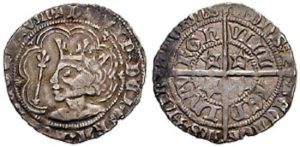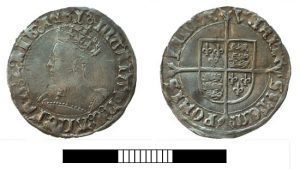Groat Meaning and Definition – What is a Groat Coin?
11/03/2021Daniel Fisher
Free & fully insured UK Delivery. Learn more
Secure & flexible payments. Learn more

Buyback Guarantee Learn more
The dictionary meaning of the word “GROAT” denotes a silver coin that was used in the 14th century across England and Scotland. The word ‘Groat’ is derived from an old French word – Gros, which meant great, or big. There is also a Dutch word – Grootpennig, which meant a big penny. Thus, the word may have been derived from either of these origins.
There is, however, another dictionary meaning of the word ‘Groat’. This refers to the seeds of grains such as oats, rye or wheat. Once the outer shell of the seat is removed, it can be cooked. However, this has nothing to do with coinage or the silver coin, in particular.

Groat coin from Scotland 1367
The Groat coin had a value of 4 pence. The French had a similar coin, which they called ‘Gros Tournois’. It is possible that the silver coin used in England and Ireland originated from this. There was a separate Scottish coin with the same name, which initially had a value of 4 pence, but was later minted as an 8 pence coin. There was also a Scottish version where the coin was worth a shilling.
The coin was initially circulated by Edward I around the year 1280. The coin became popular and enjoyed circulation in England for the next two centuries as the largest silver coin at the time. Eventually, its place was taken by other large coins such as the Shilling introduced by King Henry VII. The coin continued to be minted until the last one, which was made in 1855.
However, mintage was stopped during certain periods. For example, King James I, whose reign was between the years 1603 to 1625, withdrew the mintage. There was also a lull in mintage from 1649 to 1660. These years are better known as the Commonwealth period. However, the Groat was issued as a proof coin twice between 1857 and 1862. In 1888, there was a colonial issue of the coin. Interestingly, the Groat has become a part of The Maundy Set, issued on Maundy Thursday every year by the Queen.
Over the years, the silver content of the coin was slowly reduced. The first English Groat contained 5.8 g of silver. During the reign of Edward III, this fell to 4.7 g and continued to become much less going forward. The Groat issued by King Henry IV had only 3.9 g of silver, which was further reduced to 3.1 g by King Edward IV. It reached 2.1 g by 1559, by which time the purity of the silver contained in the coin had also fallen. After 1561, the coin was withdrawn from circulation for the next hundred years.

Groat coin found in Oxfordshire
Groats were minted only a few times during later years. By this time, it had come to be known as a 4 pence coin. There were a few years mintage after 1786, these years being 1792, 1795 and 1800. The colonial Groat that we discussed earlier, was minted in 1888.
This colonial issue was intended for the countries of British Guyana and the British West Indies, both of which were part of the British Empire at the time. The British Guyana version remained in circulation up to 1955.
Physical Gold is one of the nation’s most reputed precious metal dealers. Our coin experts are best placed to guide you on the purchase of rare and historical coins. If you have such a coin in your possession, it is best to speak to a member of our team for its evaluation. Call us on (020) 7060 9992 or get in touch with us via our website.
Image credits: Wikimedia Commons and Wikimedia Commons
Live Gold Spot Price in Sterling. Gold is one of the densest of all metals. It is a good conductor of heat and electricity. It is also soft and the most malleable and ductile of the elements; an ounce (31.1 grams; gold is weighed in troy ounces) can be beaten out to 187 square feet (about 17 square metres) in extremely thin sheets called gold leaf.
Live Silver Spot Price in Sterling. Silver (Ag), chemical element, a white lustrous metal valued for its decorative beauty and electrical conductivity. Silver is located in Group 11 (Ib) and Period 5 of the periodic table, between copper (Period 4) and gold (Period 6), and its physical and chemical properties are intermediate between those two metals.